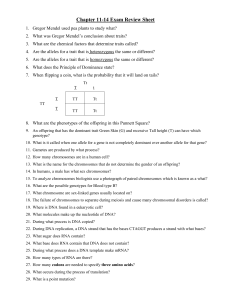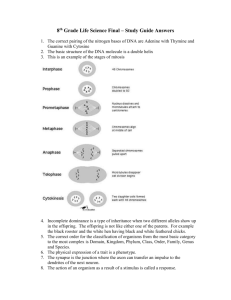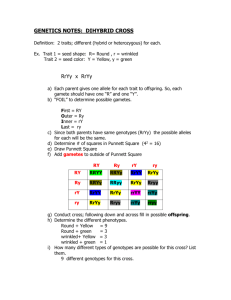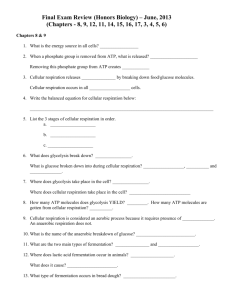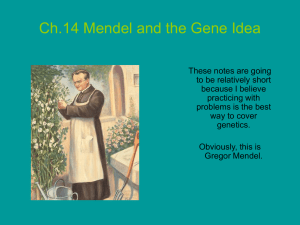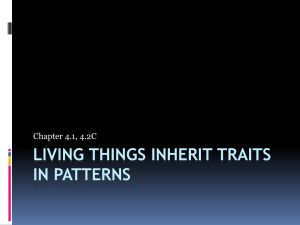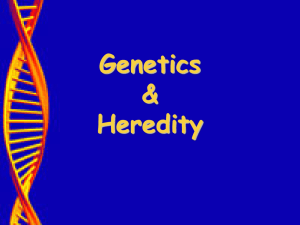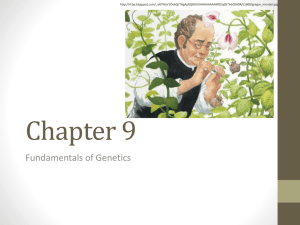Genetics: The Basics - Arapahoe High School
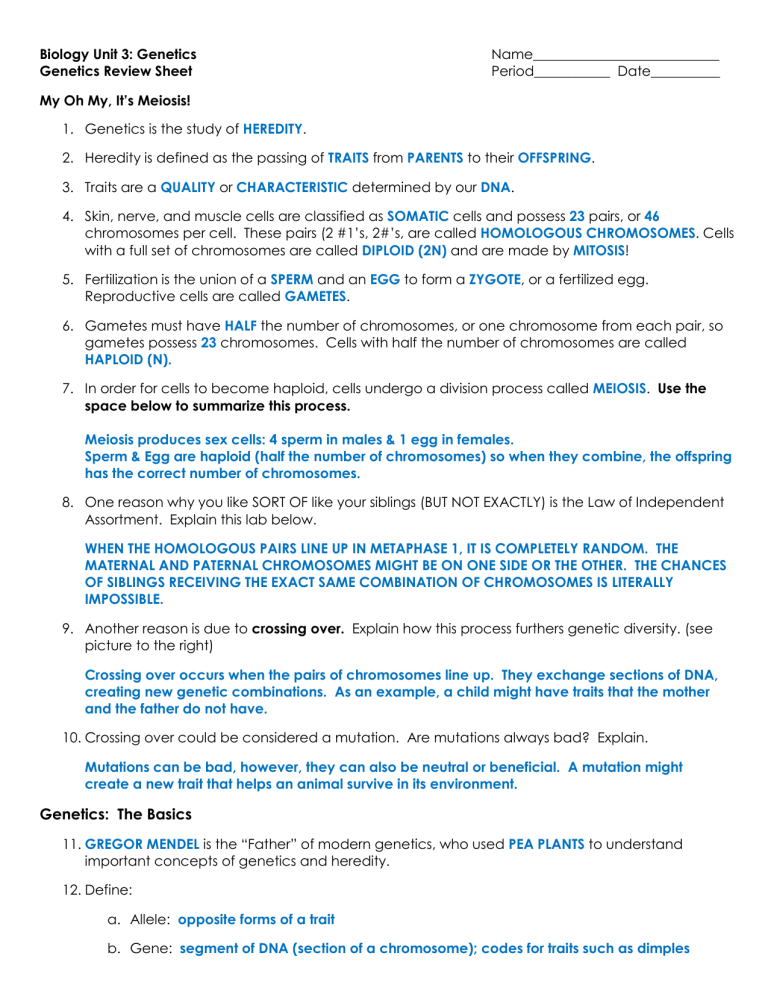
Biology Unit 3: Genetics
Genetics Review Sheet
My Oh My, It’s Meiosis!
Name___________________________
Period___________ Date__________
1.
Genetics is the study of HEREDITY .
2.
Heredity is defined as the passing of TRAITS from PARENTS to their OFFSPRING .
3.
Traits are a QUALITY or CHARACTERISTIC determined by our DNA .
4.
Skin, nerve, and muscle cells are classified as SOMATIC cells and possess 23 pairs, or 46 chromosomes per cell. These pairs (2 #1’s, 2#’s, are called HOMOLOGOUS CHROMOSOMES . Cells with a full set of chromosomes are called DIPLOID (2N) and are made by MITOSIS !
5.
Fertilization is the union of a SPERM and an EGG to form a ZYGOTE , or a fertilized egg.
Reproductive cells are called GAMETES .
6.
Gametes must have HALF the number of chromosomes, or one chromosome from each pair, so gametes possess 23 chromosomes. Cells with half the number of chromosomes are called
HAPLOID (N).
7.
In order for cells to become haploid, cells undergo a division process called MEIOSIS . Use the
space below to summarize this process.
Meiosis produces sex cells: 4 sperm in males & 1 egg in females.
Sperm & Egg are haploid (half the number of chromosomes) so when they combine, the offspring has the correct number of chromosomes.
8.
One reason why you like SORT OF like your siblings (BUT NOT EXACTLY) is the Law of Independent
Assortment. Explain this lab below.
WHEN THE HOMOLOGOUS PAIRS LINE UP IN METAPHASE 1, IT IS COMPLETELY RANDOM. THE
MATERNAL AND PATERNAL CHROMOSOMES MIGHT BE ON ONE SIDE OR THE OTHER. THE CHANCES
OF SIBLINGS RECEIVING THE EXACT SAME COMBINATION OF CHROMOSOMES IS LITERALLY
IMPOSSIBLE.
9.
Another reason is due to crossing over. Explain how this process furthers genetic diversity. (see picture to the right)
Crossing over occurs when the pairs of chromosomes line up. They exchange sections of DNA, creating new genetic combinations. As an example, a child might have traits that the mother
and the father do not have.
10.
Crossing over could be considered a mutation. Are mutations always bad? Explain.
Mutations can be bad, however, they can also be neutral or beneficial. A mutation might
create a new trait that helps an animal survive in its environment.
Genetics: The Basics
11.
GREGOR MENDEL is the “Father” of modern genetics, who used PEA PLANTS to understand important concepts of genetics and heredity.
12.
Define: a.
Allele: opposite forms of a trait b.
Gene: segment of DNA (section of a chromosome); codes for traits such as dimples
Genetics Problems:
13.
Name the 5 steps to follow when working any genetics problem:
Make a Key Choose letters to represent each trait.
Write the Cross Aa x AA
Determine Possible Sex Cells Mom could give…, dad could give…
Complete the Punnett Square Clear and neat
Answer the problem Write a ratio and answer the question(s)
Monohybrid: A cross involving ONE trait. (two alleles, one is dominant over the other)
14.
In pea plants, green (G) is dominant to yellow (g). a.
A homozygous yellow plant would have what genes for this trait? gg b.
What is the phenotype for a plant with the genotype Gg? Green c.
If a homozygous green plant is crossed with a homozygous yellow plant, what genotypes and phenotypes would you expect the F1 generation to have?
Cross: GG X gg
Punnett Square:
G G g
Gg Gg g Gg Gg d.
Answer the Question: PH: 100% Green; G: 100% Gg
15.
A cross between two heterozygous parents, where Blue (B) is dominant to white (b), what are the phenotypic and genotypic ratios of the F1 generation?
Cross: Bb X Bb
Punnett Square: B b
B
BB Bb b
Bb bb
Phenotypic Ratio: 3 blue : 1 white (F1 generation)
Genotypic Ratio: 1BB : 2 Bb : 1bb (F1 generation)
Codominance: A cross involving two DOMINANT ALLELES .
16.
In shorthorn cattle, when a red bull (RR) is crossed with a white cow (WW), all the offspring are roan—a spotted, red and white or milky red color. a.
What are the chances of the offspring resulting in red cattle, when a roan bull is crossed with a roan cow?
Cross: Cross: RW X RW
Punnett Square:
R
R RR
W RW
W
RW
WW b.
Answer the Question: There are three different ways to represent this answer.
1.
25 %
2.
1/4 Fraction
3.
.25
Decimal
Incomplete Dominance: A cross when 2 ALLELES influence the phenotype.
17.
In human hair, straight hair demonstrates incomplete dominance (S) over curly hair (c). In the heterozygous condition, wavy hair (Sc) is the resulting mix. a.
What are the chances of the offspring resulting in wavy hair, when straight hair is crossed with wavy hair ?
Cross: SS X Sc
Punnett Square:
S c
S SS Sc
S SS Sc b.
Answer the Question: There are three different ways to represent this answer.
4.
50 %
5.
1/2 Fraction
6.
.50
Decimal
Multiple Alleles: Traits controlled by more than 2 alleles.
18.
Name three examples of traits that have multiple alleles. BLOOD TYPES, SKIN COLOR, EYE COLOR
19.
PARENTS 1 CHILD C
PARENTS 2 CHILD D
PARENTS 3 CHILD A
PARENTS 4 CHILD B
X-Linked Traits: Genes found on the X chromosome.
20.
Two common, recessive, X-linked traits are: HEMOPHILIA and COLORBLINDNESS
21.
XX= FEMALE symbol?
♀
XY= MALE symbol?
♂ a.
Hemophilia is an X-linked trait. Normal clotting (H) is dominant over hemophilia (h). A heterozygous normal (carrier) female is crossed with a male who has hemophilia. What are the results of their offspring?
Cross: X H X h X X h Y
Punnett Square: X h
X H X h
X H
Y
X H Y
X h X h X h Y
X h
Results: 25% - female carrier
25% - female with hemophilia
25% - normal male
25% - hemophiliac male
Pedigree
22.
Determine the genotype of each individual in the pedigree and write the genotype next to each individual above.
Use the following key to answer the questions: F = Normal f = Cystic Fibrosis
X f Y ff X F X f Ff
X F X f Ff
X F Y Ff
X f Y ff
X F X f Ff
X f X f ff X F Y Ff
Dihybrid Cross: Cross involving 2 traits.
23.
In pea plants, the allele for round seeds (R) is dominant over wrinkled seeds (r), and the allele for yellow seeds (Y) is dominant over the allele for green seeds (y). a.
What are the results of a cross between two heterozygous round, yellow pea plants?
Cross: RrYy X RrYy
Punnett Square:
RY Ry
RY
Ry
RRYY
RRYy
RrYY rY ry
RrYy
RRYy
RRyy
RrYy
Rryy
rY ry
RrYY
RrYy rrYY rrYy
RrYy
Rryy rrYy rryy
Results:
Ratio : ** 9 : 3 : 3: 1**
Karyotype: A picture of an individual’s CHROMOSOMES .
24.
Name two things that we are able to determine by evaluating karyotypes: SEX, DISORDERS
26. Down’s Syndrome babies carry an extra 21 chromosome.
27. Klinefelter’s Syndrome means that a person has an extra X (XXY) chromosome.
